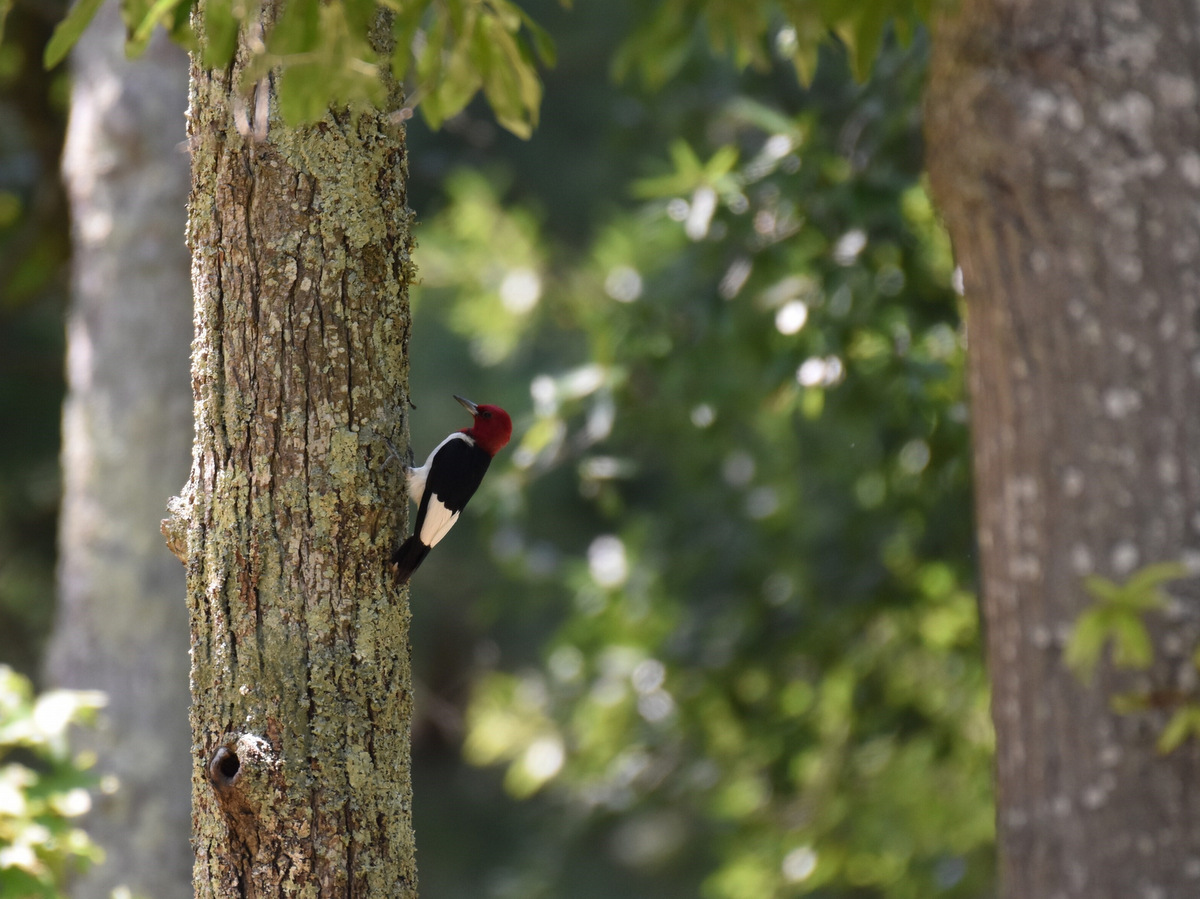It took a pandemic to turn me into a birder. Deprived of my former hobbies, I learned how to put out food, water, and nesting material for my Northern Californian neighbors. The dramatic, foolhardy ones, the hummingbirds and chickadees, quickly discovered my gifts. So did the squirrels. The jays made trouble. The doves whistled down, and a hawk found the doves. It was months before I was able to lure the first woodpecker, a shy little wooden soldier, to my suet feeder. Just a Downy, but I was elated.
For reasons that are not entirely clear (though mimicry is surely one factor), most North American woodpeckers, including my own Downy, possess a similar plumage pattern: black-and-white bodies, often a dash of red on the head. However, one species found in the Finger Lakes during the breeding season, the Red-Headed Woodpecker (Melanerpes erythrocephalus), has taken this basic design to an extreme level of abstraction. Boldly color-blocked with a scarlet head, white belly and wing tips, and glossy black everywhere else, it is as arresting as a Piet Mondrian runway creation.

Photo: lwolfartist_CC BY 2.0
Woodpeckers are not highly sexually dimorphic to begin with, but the Red-Headed adults look identical to each other. Generally speaking, the more similar the appearance of the sexes within a species, the more equal their share of the breeding duties. Unsurprisingly, the Red-Headed males are extremely helpful at home, drilling nesting cavities in dead trees, removing droppings, and warming the babies at night. On the other hand, the outrageous colors of male tanagers and the elaborate furbelows of tom turkeys are signs that the plain-dressed females must raise the young by themselves.
Unlike the untidy flump of a wood pigeon or the chastisement of goldfinches, the movements of a woodpecker are perfectly calibrated. Holding on to a tree trunk with its feet (which have the same grappling-hook shape as parrot feet) and leaning back onto its very stiff tail feathers, it pops forward repeatedly like a wind-up toy. It can scoot upwards or sideways with surprising speed, combing through trees like an obsessively neat corn-on-the-cob eater.
Woodpeckers are common enough – they are found almost everywhere in the world – that it is easy to forget that they are marvels of natural engineering. Their chisel-shaped beaks are self-sharpening, their third eyelids automatically block flying woodchips, their bristles keep them from breathing dust, and their heads are impervious to concussions. Their tongues, which are used to lap up insects and sap, are so long that they are anchored at the nostrils and wrap around the back of their brains. The Red-Headed, preferring to do things a little differently, can drill for insects but prefers to catch them on the wing. It also gathers acorns and beech nuts, takes mice and berries from the forest floor, and even raids the nests of other birds. It industriously tucks what it gathers (including some very unfortunate live grasshoppers) into hidey-holes, covering everything with bark.
That rapid, clattering tattoo, often the only hint that there is a woodpecker in the neighborhood, probably isn’t the sound of a bird looking for food or making a nest, but an urgent message in Morse code. It might be a boast, a romantic invitation, or an alarm call, and its length reveals the drummer’s fitness. For maximum sound projection, a resonant surface like a hollow tree or the gutter of your house is ideal.
Neighborhood woodpeckers are charming, but they also assure us that we are living in a healthy ecosystem. Although most species seem to be doing well in the Finger Lakes, Red-Headed numbers are in steady decline. The clearing of beech and oak forests and the decimation of the chestnut forests by blight starved them; farmers and cars were not kind to the survivors. Humans like to get rid of the untidy dead and dying trees where they live, and there is now hot competition, particularly with European Starlings, for the remaining places to nest. The good news is that they will use nest boxes and that they love suet – however, I would suggest that you only use the hot-pepper kind because it dissuades squirrels.
Next time: how the pandemic taught me to respect squirrels.

